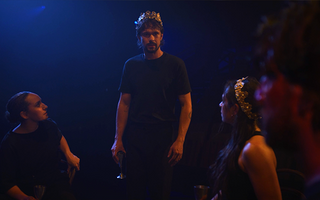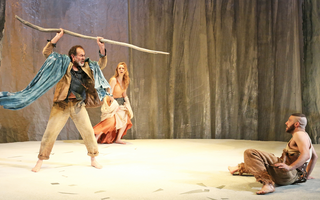 Watch
Watch
Shakespeare’s plays are filled with incredible language, but what techniques are at work? Here’s a list of just some of the many literary and theatrical techniques that Shakespeare employs, with examples as spoken by his characters.
Anaphora
The deliberate repetition of words, or sequences of words, at the beginning of a line or phrase for effect. As well as emphasising ideas, the rhythm of anaphora makes the words memorable and signals that the character speaking is intent on their point being heard.
Example:
JULIET
Well, do not swear: although I joy in thee,
I have no joy of this contract to-night:
It is too rash, too unadvised, too sudden;
Too like the lightning, which doth cease to be
Ere one can say 'It lightens.'
Romeo and Juliet, Act 2, Scene 2
Juliet uses anaphora in explaining to Romeo the reasons why they should not pursue their relationship and organise a swift marriage. The hard consonant ‘T’ sound and repetition of “too” creates a listing effect, and a stark contrast to the heightened romance of their language for the majority of the scene.
Antithesis
A device in which two opposite things or ideas are placed side by side for contrasting effect. Shakespeare used antithesis extensively in his plays, especially in soliloquies. Placing these opposites in close proximity to each other emphasises their difference and is reflective of the tensions and complexities within the plays and characters.
Examples:
WITCHES
Fair is foul, and foul is fair.
Macbeth, Act 1, Scene 1
HAMLET
To be, or not to be, that is the question
Hamlet, Act 3, Scene 1
Aside
A remark or comment directed to the audience by a character, that is not heard by any other character on stage. An aside is usually an unspoken thought or comment on the action, that a character could not or would not voice in front of other characters.
Example:
KING CLAUDIUS
But now, my cousin Hamlet, and my son,--
HAMLET
[Aside] A little more than kin, and less than kind.
Hamlet, Act 1, Scene 2
Hamlet’s aside instantly establishes a connection with the audience that will continue for the duration of the play, as well as giving insight to his true feelings towards his uncle that he cannot show openly.
Dramatic Irony
A device in which the audience’s understanding or knowledge surpasses that of the character or characters on stage. Shakespeare employs the device throughout his plays for different effect.
Examples:
In comedy, dramatic irony may be used for humorous effect. For example, in A Midsummer Night’s Dream we know that the young lovers have been put under a spell, yet they do not. Their confusion provides great amusement for the audience.
In tragedy however, the effect of dramatic irony can be heartbreaking for the audience. For example, at the end of Romeo and Juliet, the audience knows that Juliet is in fact alive when Romeo believes she is dead. In Othello, the audience is forced to watch Iago convince Othello that his wife, Desdemona, is unfaithful even though we know she is not. Shakespeare understood very well the impact of dramatic irony for an audience, in that while we have the information, we cannot inform the characters or change their fate in any way.
Iambic Pentameter
The most common form of verse that Shakespeare used to write his plays. Iambic Pentameter translates to the ‘rhythm of five iambs.’ An iamb is a unit of two syllables – one soft, one strong – and sounds similar to a heartbeat. Many, many common English language words follow this iambic rhythm. Some examples are begin, hello, goodbye, police, delay, and away. In speaking the iamb, the emphasis is naturally on the second syllable, not the first.
Each line of iambic pentameter is ten syllables long, and rhythmically sounds like:
Duh duh, duh duh, duh duh, duh duh, duh duh.
Examples:
ROMEO
But soft, what light through yonder window breaks?
Romeo and Juliet, Act 2 Scene 2
MACBETH
So foul and fair a day I have not seen.
Macbeth, Act 1, Scene 3
ORSINO
If music be the food of love play on.
Twelfth Night, Act 1, Scene 1
The rhythm of iambic pentameter helps us make sense of the words the characters speak, with important syllables stressed. When characters speak regular iambic pentameter, as in the examples above, we know that they are clear-headed and intentioned. However, Shakespeare breaks his own rules in iambic pentameter for deliberate effect, to reflect a character’s state of mind. For example, Hamlet’s often irregular iambic pentameter:
HAMLET
To be, or not to be, that is the question...
Hamlet, Act 3, Scene 1
The first four lines in this soliloquy have eleven syllables, giving each line an extra beat, sometimes referred to as a ‘weak’ ending. The rest of Hamlet’s speech is uneven, with lines of varied syllables. This makes it much less clear about which words might have emphasis, and this reflects Hamlet's state of mind. In this soliloquy Hamlet is uncertain, conflicted and unsure of his next move. He is not clear-headed and he even sounds off-kilter to the audience. Contrast this with Romeo’s clear, regular meter when he sees Juliet at her window. In this way, Shakespeare uses meter and verse in the place of stage directions and gives us insight into a character's state of mind.
Imagery
Using figurative language to describe or represent feelings, thoughts, experiences or things, commonly visual images. Shakespeare was a master of imagery, creating vivid visual images in the mind of his audience through words, particularly in his tragedies. Often, Shakespeare uses repetition of imagery, such as in Macbeth where images of blood abound, long after the literal blood has been spilled. This amplifies Macbeth’s dark deeds and emphasises Macbeth and Lady Macbeth’s feelings of guilt.
Examples:
MACBETH
I am in blood
Stepp’d in so far that, should I wade no more
Returning were as tedious as go o'er.
Macbeth, Act 3, Scene 4
MACBETH
Will all great Neptune's ocean wash this blood
Clean from my hand? No, this my hand will rather
The multitudinous seas in incarnadine,
Making the green one red.
Macbeth, Act 2 Scene 2
LADY MACBETH
Here's the smell of the blood still: all the
perfumes of Arabia will not sweeten this little
hand. Oh, oh, oh!
Macbeth, Act 5, Scene 1
Soliloquy
A speech by a character that is shared only with the audience, and no other character on stage. The character may be talking to themselves, or talking directly to the audience, though the effect is a shared private moment with the audience. In a soliloquy, a character will often share their true feelings and intentions, or thoughts and concerns that they have not shared with any other characters. In some cases, characters may witness a soliloquy though the speaker does not know they are in earshot, such as Juliet’s soliloquy at her window that is overheard by Romeo.
Examples:
MACBETH
Is this a dagger which I see before me,
The handle toward my hand? Come, let me clutch thee.
I have thee not, and yet I see thee still.
Art thou not, fatal vision, sensible
To feeling as to sight? or art thou but
A dagger of the mind, a false creation,
Proceeding from the heat-oppressed brain?
Macbeth, Act 2, Scene 1
JULIET
Come, night; come, Romeo; come, thou day in night;
For thou wilt lie upon the wings of night
Whiter than new snow on a raven's back.
Come, gentle night, come, loving, black-brow'd night,
Give me my Romeo; and, when he shall die,
Take him and cut him out in little stars,
And he will make the face of heaven so fine
That all the world will be in love with night
And pay no worship to the garish sun.
Romeo and Juliet, Act 3, Scene 2
Sonnet
A sonnet is a poem consisting of fourteen lines, written with a specific rhyme scheme and structure. Shakespeare wrote sonnets in iambic pentameter, so that each line has ten syllables. The first twelve lines of a sonnet are divided into three quatrains of four lines each. The final two lines of the sonnet takes the form of a rhyming couplet. The rhyme scheme followed for the three quatrains and couplet is abab-cdcd-efef-gg.
In a sonnet, the writer presents and explores an argument, theme or problem in the opening three quatrains, and then resolves the argument quickly in the final couplet.
Shakespeare wrote 154 sonnets, but the form originated in 13th century Italy and has been used by writers throughout history. Sonnet writing continues to be popular to this day.
Examples:
SONNET 130
My mistress' eyes are nothing like the sun;
Coral is far more red than her lips' red;
If snow be white, why then her breasts are dun;
If hairs be wires, black wires grow on her head.
I have seen roses damask'd, red and white,
But no such roses see I in her cheeks;
And in some perfumes is there more delight
Than in the breath that from my mistress reeks.
I love to hear her speak, yet well I know
That music hath a far more pleasing sound;
I grant I never saw a goddess go;
My mistress, when she walks, treads on the ground:
And yet, by heaven, I think my love as rare
As any she belied with false compare.
Interestingly, when Romeo and Juliet first meet, their first lines to each other form a sonnet. There are fourteen lines exactly from first words to first kiss. We can infer what Shakespeare meant by doing this, but we can assume that it is a deliberate technique. The two lovers speaking instantly to each other in quite a difficult, very romantic verse structure, signals that their love and their meeting is significant.
ROMEO
[To JULIET] If I profane with my unworthiest hand
This holy shrine, the gentle fine is this:
My lips, two blushing pilgrims, ready stand
To smooth that rough touch with a tender kiss.
JULIET
Good pilgrim, you do wrong your hand too much,
Which mannerly devotion shows in this;
For saints have hands that pilgrims' hands do touch,
And palm to palm is holy palmers' kiss.
ROMEO
Have not saints lips, and holy palmers too?
JULIET
Ay, pilgrim, lips that they must use in prayer.
ROMEO
O, then, dear saint, let lips do what hands do;
They pray, grant thou, lest faith turn to despair.
JULIET
Saints do not move, though grant for prayers' sake.
ROMEO
Then move not, while my prayer's effect I take.
Romeo and Juliet, Act 1, Scene 5
Stichomythia
Dialogue in which a single line spoken by one character is answered by another character’s line that plays off the language of the first. Stichomythia (pronounced stick-oh-mith-ee-uh) is true wordplay, as if a tennis match with words. One character will serve a line of dialogue to another character who returns a similar line of text, with some pointed changes. Antithesis is used within stichomythia frequently, providing counterpoints between two characters and their argument.
Examples:
HERMIA
I frown upon him, yet he loves me still.
HELENA
O that your frowns would teach my smiles such skill!
HERMIA
I give him curses, yet he gives me love.
HELENA
O that my prayers could such affection move!
HERMIA
The more I hate, the more he follows me.
HELENA
The more I love, the more he hateth me.
A Midsummer Night’s Dream, Act 1, Scene 1
QUEEN GERTRUDE
Hamlet, thou hast thy father much offended.
HAMLET
Mother, you have my father much offended.
QUEEN GERTRUDE
Come, come, you answer with an idle tongue.
HAMLET
Go, go, you question with a wicked tongue.
Hamlet, Act 3, Scene 4
Symbolism
A device in which symbols are used to represent ideas or qualities, beyond an object’s literal meaning. For example, the way an image of a heart symbolises love, or an image of a dove can symbolise peace. In this way, symbolism requires the audience to make the connection between the literal object and the meaning it conveys. Shakespeare used symbolism frequently to convey deeper meaning and ideas, making it a more sophisticated technique than merely describing something.
Examples:
MACBETH
Is this a dagger which I see before me,
The handle toward my hand? Come, let me clutch thee.
I have thee not, and yet I see thee still.
Art thou not, fatal vision, sensible
To feeling as to sight? or art thou but
A dagger of the mind, a false creation,
Proceeding from the heat-oppressed brain?
Macbeth, Act 2, Scene 1
The dagger is a key symbol used by Shakespeare, in demonstrating Macbeth’s spiralling state of mind before he murders King Duncan. In this soliloquy, the dagger symbolises many things, be it the actual act of murder, guilt, Macbeth’s conscience, fear, fate or other ideas. The audience will infer their own meaning on the symbol, and therefore symbolism is open to interpretation.








